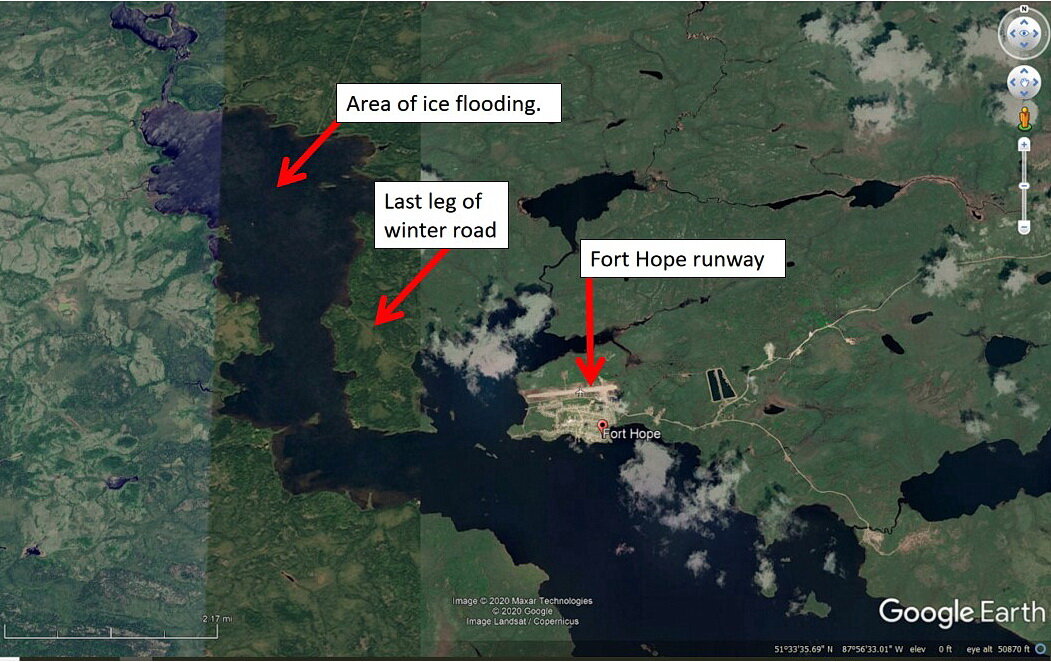Far North Rambles: How Big Was The Crack?
On my 2nd winter road trip, I experienced disturbing flooding on a lake crossing. Were they flooding the ice road or was it a big crack in the lake ice?
I used a rental truck on my 1st winter road trip. That was probably not a good idea. For my 2nd winter road trip, I asked the Thunder Bay staff of the Ontario Geological Survey to prepare a Ministry vehicle for me to drive to Fort Hope.
I didn’t specify what “prepare” meant. I was overwhelmed when I picked up the truck. I was presented with a white, 3/4 ton, 4x4 truck. It had winches on the front and on the back, neither of which I knew how to use. The truck box was filled with emergency sleeping gear, a huge wooden box full of mysterious tools, several red plastic fuel containers, spare tires, and other assorted items. I felt like a truck repair shop on wheels. I was ready to tackle the Baja 1000!
I provided a link to the a Spot Satellite track so that Andy Yesno, the senior adviser to Eabametoong First Nation and a mentor to me, could monitor my journey and mount a search and rescue party if needed (hopefully not needed).
I stopped at Kabania junction to eat my granola bars, packaged meat, and bread for dinner. I found out afterward that some in Fort Hope started to wonder if I had broken down. Reassuring and touching.
The last leg into Fort Hope was across two short segments of ice road on Eabamet Lake (Photo 1). I had not encountered slush or surface water on the trip, so I was was excited to start across the lake. Water! Suddenly, I was driving through water!
Photo 1: Google Earth image of the last kilometre of winter road into Fort Hope, only using a summer satellite image. The arrows show: a) the area of ice road flooding; b) the last land leg across the peninsula; and c) the location of the Fort Hope runway.
“They must be flooding the ice road to make it thicker”. But, I saw no lights from the winter road crew.
The lake ice must have cracked. Lake water was flooding up onto the ice surface. I understood this was normal, but I was concerned. Where was the crack? How wide was the crack? Had the crack weakened the ice road?
I drove slowly (ice road rule) and moved over to the very edge of the ice road, where there was less water. Then I remembered, the ice road is thick in the middle and thins towards the edge. I was now driving my excessively well prepared, but very heavy truck, over what had to be the weakest part of the ice road. Not good. Not wanting to break through the ice, I split the difference, moved away from the road edge, but stayed away from the deeper flood water, where my imagination told me the gaping open crack sat. Imagination plays games after a stressful 12 hour drive, at night, on a winter road, in the middle of flood water. I had my window open and door ajar in case the truck went through the ice. Standard ice road practice, I recalled. It was not calming. I could hear the lake ice cracking beneath the truck. “Normal” I recalled. I was not in the mood for “normal”.
Half way across the lake, the water disappeared. Deep breath of relief. One short bush segment and back on to the last ice road segment. I saw the lights of Fort Hope (Photo 2). Great relief, but sudden stress-release fatigue.
Photo 2: Lights of Fort Hope across Eabamet Lake from the winter road. Almost there. Feb. 2, 2011.
One more challenge. I needed to ensure I did not stray off the winter road on to the Fort Hope airport runway. They both ran immediately beside each other. I understood it was “bad” to drive a truck on an active runway!
The trip ended well. The four-day visit was excellent.
I do reflect on the flooded ice road and wonder to this day “how big was the crack”? It gets smaller as each year passes. LOL.
Andy Fyon, Sept 18, 2020 (Facebook, May 22, 2020).
Have A Question About This Note?
We might reflect: a) was the intent of the treaties to be fair? b) was the intent of the treaties to be respectful?; c) was the intent of the treaties to be sharing agreements?; and d) was the intent of the treaties to maintain the honour of the Crown? I leave those questions for you to reflect on, as a treaty person. Recall, we are all treaty people. The concept of “Left over land” stuck with me.
Andy Fyon, Sept 18, 2020 (Facebook, May 22, 2020).
Have A Question About This Note?


